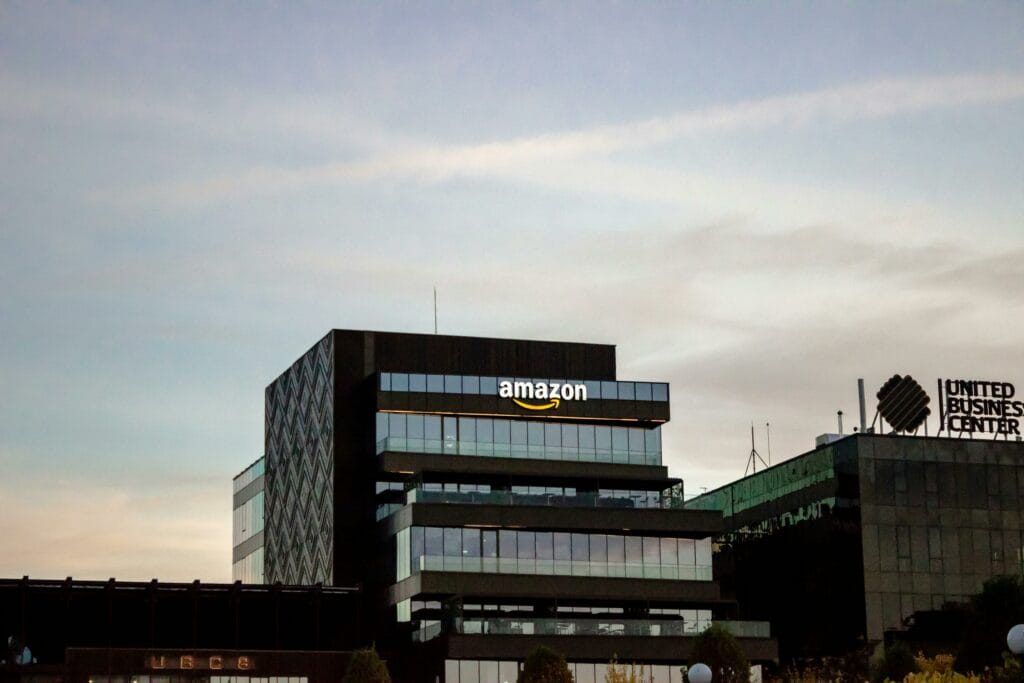Welcome to the Future of eCommerce: Insights from Amazon’s Playbook
If you’re aiming to keep your finger on the pulse of the eCommerce world, you’re in the right place. In this week’s coverage on The Checkout Point—brought to you by Blikket.co—we’re diving deep into the transformative moves Amazon is making to reshape the digital marketplace. This analysis isn’t just about headline-grabbing news; it’s about understanding the underlying strategies that could revolutionize how you engage with eCommerce.

Amazon’s latest tactics are not merely enhancements to the consumer experience; they are setting the benchmark for consumer expectations and market dynamics across the globe. From leveraging cutting-edge technology to pioneering new consumer behavior, Amazon’s strategies provide a blueprint for what’s next in eCommerce. We’ll dissect these moves and what they mean for businesses like yours.
Additionally, brace yourself for an exploration of significant shifts in international trade policies, such as the USPS ceasing package deliveries from China, and their broader implications on global eCommerce. This week’s session is crammed with critical insights, including the latest in eCommerce advertising innovations and strategic shifts among major digital marketing players like Bento and Amazon themselves.
Whether you’re a seasoned eCommerce manager, a marketer looking to enhance your campaigns, or an online store owner eager to stay ahead, these insights are tailored to help you maintain a competitive edge. So grab your notebook, and let’s delve into these strategic revelations that are defining the future of digital commerce.
Smart Automation and Real-Time Optimization
One of Amazon’s groundbreaking strategies that truly demonstrate its pioneering role in ecommerce is the automatic setting of seller handling capacities. Imagine the scenario: you’re an Amazon marketplace seller, your day-to-day is a dizzying mix of managing inventory, fulfilling orders, and coordinating customer service. Now, picture a world where Amazon utilizes its vast troves of performance data to automatically optimize your order handling capabilities. Yes, without your intervention. The tech giant employs powerful algorithms and analytics to ensure that every seller operates at their optimum without risking order overwhelm or customer dissatisfaction. This is not just automation, it’s smart automation finely tuned to the real-time dynamics of ecommerce.

Strategies Driving Market Dominance
Further illustrating Amazon’s strategic acumen, the company noted a remarkable 10% growth in sales during the fourth quarter of 2024. In an era marked by economic unpredictability, achieving double-digit growth is nothing short of impressive. This surge reflects robust consumer confidence and a deep-seated preference for Amazon’s vast product offerings and Prime exclusivities. But it’s not just the broad product spectrum; strategic timing of promotions also plays a critical role. The well-timed end-of-year deals and holiday promotions, as discussed on EcommerceBytes, have mastered the art of enticing users to hit the coveted ‘Buy Now’ button.

Pioneering Customer Retention with Prime Perks
Last but certainly not least, the extraordinary value delivered to Amazon Prime members sets a benchmark in customer loyalty strategies. In 2024, Prime members enjoyed significant savings on delivery costs—amounting to hundreds of dollars. This strategic approach not only boosts the perceived value of a Prime membership but also enhances the entire Amazon ecosystem. By bundling services like Amazon Video and Music, the platform transforms from a mere shopping destination to an integral part of everyday entertainment and convenience. The concept is simple yet effective: the more a customer interacts with Amazon’s services, the more they save and cherish the experience. Check out the detailed benefits here.
Through these strategies, Amazon does more than just adjust to consumer needs; it shapes and anticipates them, setting new standards in the ecommerce industry. Each algorithm improvement, sales event, and Prime perk is an opportunity for Amazon to deepen its understanding of consumer behavior, enhancing their offerings to strategically meet evolving demands. For any retailer aiming to stay relevant, the message from Amazon’s playbook is clear: adapt to your customer’s evolving preferences, or risk fading into obsolescence.

Global Impacts: The Ripple Effect of USPS’s Suspension on E-commerce
Awaiting the arrival of a newly ordered gadget or a heartfelt gift can be one of the simplest joys in today’s interconnected world. However, this delight transforms into frustration when delays or cancellations, like the recent USPS’s suspension of packages from China, intervene. Such disruptions ripple across the ocean of global trade, affecting businesses, consumers, and economic relationships internationally.

Navigating the Intricacies of Global Trade Disruptions
For many eCommerce businesses, this suspension isn’t just a minor glitch; it’s a substantial obstacle. China’s role as a global manufacturing powerhouse makes it a critical node in the supply networks of countless industries. From tech gadgets to fashion, numerous sectors rely on Chinese production for both goods and components. When such a vital link is paused, the effect is not just a delay in shipment but a potential escalation in product scarcity and costs.
One might wonder, why would the USPS initiate such a significant disruption? The reasons span across political tensions, trade disputes, logistical strains, or even health concerns impacting international safety. Each cause reflects the complexity of our modern economic and diplomatic landscapes, where decisions in one nation can set off a chain reaction affecting global markets.
The Broader Economic Consequences
The consequences of a suspension like this reverberate well beyond delayed deliveries. Businesses, especially smaller eCommerce ones, could wrestle with getting their inventory, leading to potential stock shortages and price inflations. Consumers might soon notice the scarcity of certain items or an uptick in their costs. Furthermore, such an action doesn’t only arrest the flow of goods but also strains the economic threads woven between countries.
This situation sheds light on the vulnerabilities of our global logistics framework—an elaborate dance of shipping containers, trucks, planes, and ships. Each player in this global ballet depends on rhythmic precision from the others, and a misstep, like this one, can disrupt the performance catastrophically.
Strategizing for Future Resiliency
In response to such disruptions, the focus quickly shifts to solution-seeking. Diversifying supply sources or increasing local manufacturing might be strategic moves to buffer businesses against global supply chain vulnerabilities. Additionally, investing in robust technological infrastructures to enhance logistics adaptability could help safeguard against future unpredictabilities.
As we reflect on the significant scale of logistical networks crucial to our daily lives—from a simple package delivery to the complexities of international economic strategies—each component plays a critical role. Remember, the next time you hit the “order” button, there’s an intricate ballet happening across the globe to bring that package to your doorstep. It’s a complex, delicate, and at times, unstable dance that moves the world of eCommerce—and indeed, the entire global economy.
Revolutionizing Online Shopping with High-Tech Advertising
In the rapidly evolving eCommerce landscape, high-tech advertising is not merely about eye-catching banners or memorable jingles. Instead, it’s transforming into a complex arena where technology like AI and enhanced digital norms shape new consumer experiences. This shift is not only making online shopping more interactive but is also setting the bar high for how ads are engineered and delivered.

Understanding Google’s New SERP Strategies
One of the significant changes in the digital advertising space is how Google has revamped its Search Engine Results Pages (SERPs). The integration of advanced JavaScript has a profound impact, making web pages more interactive without constant reloading. Recent adjustments by Google (as discussed here) are pivotal as they modify how these scripts impact tracking and AI tools used by marketers to scrutinize website traffic and user engagement. This evolution in SERPs is crucial for advertisers as it directly influences the efficacy of ads and the granularity of data-driven advertising strategies.
Clamping Down on Misleading Ads
Google is also intensifying its efforts to create a more honest internet space by penalizing misleading advertisements. This clampdown means that any eCommerce platform attempting to lure customers through deceptive ads leading to irrelevant landing pages will face demotion. This initiative discussed here, heralds a move towards more transparency in online shopping, ensuring that user experiences are not only engaging but also trustworthy.
The Advent of AI-Driven Advertising
The burgeoning field of AI-driven advertising is turning heads with its potential to personalize consumer experiences profoundly. A notable example was during the 2025 Super Bowl, where ads seemed custom-fit not just to general audiences but to individual preferences based on shopping history, browsing habits, and location. This leap towards personalized advertising, as seen in this TechCrunch article, illustrates how dynamically tech is being harnessed to target specific demographics more accurately than ever before.
This technological progression in eCommerce advertising is reshaping how brands connect with consumers, making engagements more relevant and cutting through the noise of generic advertising. As we continue steering through these innovations, the bond between technology and consumer interaction only seems to be strengthening, promising a future where eCommerce is as personal as it is technological.
Understanding these advancements is not just for tech enthusiasts or marketers but for anyone curious about the evolving digital landscape of consumerism. As we delve deeper, the fusion of technology and commerce promises to offer more engaging, transparent, and responsive shopping experiences, driven by a better understanding of consumer needs and behavior.
Revolutionizing Ecommerce: Bento and Amazon Lead the Charge
In today’s fast-paced digital realm, two prominent players, Bento and Amazon, are redefining the ecommerce and advertising landscape. Their innovative approaches not only enhance business strategies but also significantly alter consumer interactions. Here’s how these platforms are shaping what’s next in the digital marketplace.

The Resurgence of Email Marketing with Bento
Email marketing, often perceived as an aging relic in the digital toolkit, has been remarkably revitalized by Bento. Bento transforms traditional email communications into a strategic asset for ecommerce entities. This platform enables brands to finetune their communications, resulting in highly personalized and engaging customer experiences. Imagine receiving emails that resonate with your preferences and shopping habits – that’s Bento’s specialty.
With Bento, it’s not about inundating customers with irrelevant promotions. Instead, it’s about crafting meaningful conversations and nurturing customer relationships through smart, adaptable content that aligns with consumer behavior and preferences.
Amazon’s Aggressive Expansion in Digital Advertising
Amazon, a household name in retail, is also making significant strides in its advertising domain, experiencing an impressive 18% growth in the recent quarter. This surge underscores a pivotal shift in advertising from traditional mediums to digital platforms, with Amazon at the forefront of this transition.
The growth of Amazon’s advertising sector is noteworthy because it epitomizes the broader industry trend of migrating ad budgets to digital frameworks that offer superior targeting accuracy. This shift allows businesses to optimize their advertising spend, ensuring that the messages delivered are precisely tailored to the interests of potential customers.
The Fusion of Personalization and Marketing
Both Bento’s cutting-edge email strategies and Amazon’s robust advertising growth illustrate a greater industry trend towards personalization in digital marketing. This movement is not only reshaping how companies reach out to potential customers but also how marketing feels and functions in everyday digital interactions.
Integral to this evolution is the sophisticated use of data to craft more intuitive and effective engagement points. This strategy results in marketing experiences that are increasingly relevant to consumers, sometimes even feeling eerily accurate.
As these technologies become more embedded in our digital lives, it becomes crucial to remain vigilant about the implications for consumer rights and privacy. The personalization of digital marketing poses unique challenges and opportunities, necessitating a balanced approach to consumer data use and privacy concerns.
The next time an advertisement catches your eye or a promotional email piques your interest, remember the intricate, data-driven processes operating behind the scenes. These advancements are shaping a new era of digital marketing that is more dynamic, tailored, and integrated into our digital world.
Indeed, we are witnessing a significant transformation in the landscape of digital marketing, driven by giants like Bento and Amazon. Their strategies showcase the potential of personalized marketing to not just reach customers more effectively, but also to enhance how we interact with and perceive digital advertising.
Strategizing with insights from these trends can provide substantial competitive advantages in the burgeoning field of Amazon eCommerce strategies, making it essential for marketers and businesses to adapt and thrive in this evolving digital marketplace.
Adapting to the Evolution of Search and Consumer Behavior
Imagine a world where your local coffee shop is replaced overnight by an establishment offering customized global coffee blends, all thanks to the wonders of advanced technology. This scenario is not limited to our morning caffeine routines, but extends across various commercial landscapes. At the core of these developments are innovations in technology and significant shifts in consumer behaviors that are reshaping how we interact with brands and products in the eCommerce sphere, particularly on platforms like Amazon.

Dwindling Dominance of Traditional Search
The longstanding supremacy of Google as the top search engine is now facing challenges. A closer look reveals that Google’s market share is gradually declining as AI-driven and region-specific search engines gain traction. This shift implies that contemporary consumers prefer more personalized and localized search experiences, pushing businesses to rethink their search engine strategies, especially in the competitive environment of Amazon’s eCommerce landscape.
Smart Bidding: Revolutionizing Google Ads
In the realm of advertising through Google Ads, advancements like Smart Bidding are transforming targeting strategies. Utilizing machine learning, Smart Bidding empowers advertisers to optimize their ads with unprecedented precision, ensuring that the right ads reach the right customers at the opportune moment. For Amazon sellers, applying these insights means engaging potential customers more effectively, boosting both visibility and conversion rates.
Tailored Strategies in B2B Marketing
Turning to the B2B sector, personalized marketing strategies are becoming the norm rather than the exception. A recent LinkedIn report underscores the shift towards creating marketing communications that resonate personally with B2B buyers, utilizing data-driven insights to predict and meet client requirements accurately. This trend is crucial for businesses on platforms like Amazon, where understanding and anticipating the needs of business customers can significantly elevate sales performance.
The integration of sophisticated technologies in search and advertisement, alongside a deeper understanding of consumer demands, is not merely altering the marketplace—it is reinventing how we approach the market. As Amazon continues to dominate the eCommerce sector, these evolving strategies offer a unique opportunity for sellers to refine their approach, ensuring they meet modern consumers exactly where they are—digitally and personally.
What the Future Holds
As we continue to navigate these changes, the question remains: what does the future hold for digital consumer interaction? With the accelerating pace of technological advancement, tomorrow might bring even more personalized experiences, making this an exhilarating time to be involved in the digital marketing space.
Engaging with these changes isn’t just beneficial; it’s essential. For anyone involved in eCommerce, from marketers to business owners, adapting these evolving tools and strategies is crucial to staying competitive and relevant in an increasingly personalized and efficient marketplace.
So, let’s stay tuned and keep adapting, as we explore the exciting, ever-evolving world of eCommerce and marketing technologies.
Reflecting on a Week of E-commerce Evolution
As we close another insightful week, it’s critical to acknowledge the continuous impact of major players like Amazon on the evolving eCommerce landscape. Through strategic maneuvers and technological breakthroughs, these giants are not just adapting to changes but are laying down the roads for future market trends. This week’s highlights from Amazon’s bold strategies to the integration of AI in advertising underscore a pivot towards an even more data-driven and personalized shopping experience.
Navigating New Challenges
The temporary halt of USPS deliveries from China presents a compelling shift in supply chain dynamics, affecting businesses and consumers alike. This development punctuates the interconnectedness of global commerce and the delicate balance that current geopolitical and logistical frameworks provide. Meanwhile, the adoption of advanced advertising technologies signals a potential renaissance in how we understand consumer behavior and engagement.
Amazon eCommerce Strategies: A Layer Deeper
Amazon’s tactical developments give rise to numerous questions about the future of eCommerce. How will businesses small and large adapt to these changing strategies? What can other companies learn from Amazon’s approach to innovation and market adaptation?
Looking ahead, perhaps one of the most intriguing aspects to consider is the role of artificial intelligence not just in advertising, but across the entire eCommerce spectrum. From AI-driven analytics to automated customer service, the possibilities for enhancing efficiency, accuracy, and personalization are boundless.
Join the Conversation
As we speculate on these developments, we invite you to weigh in with your insights. What strategies are you considering in response to these shifts? How do you perceive the impact of AI and technology in your day-to-day eCommerce operations? Do you see Amazon’s recent moves as a blueprint for future business models, or merely as a stepping stone to something greater?
Engage with us in the comments below or on our social media platforms. Your feedback not only enriches the conversation but also helps forge a community well-versed in the nuances of eCommerce strategy. And remember, whether you’re reassessing your business approach or merely curious about the next big trend, keeping informed and adaptable is key in the bustling world of eCommerce.
Stay tuned to Blikket.co for more up-to-the-minute coverage and expert analyses. Let’s navigate these exciting times together, understanding and mastering the art of eCommerce innovations. Until next week, keep optimizing and revolutionizing your eCommerce strategies!
Your Thoughts?
What areas of Amazon’s eCommerce strategies do you find most pivotal for your business? How are you planning to implement or counteract these trends? Let’s discuss in the comments below—your insights could provide valuable perspectives to peers and newcomers alike!










